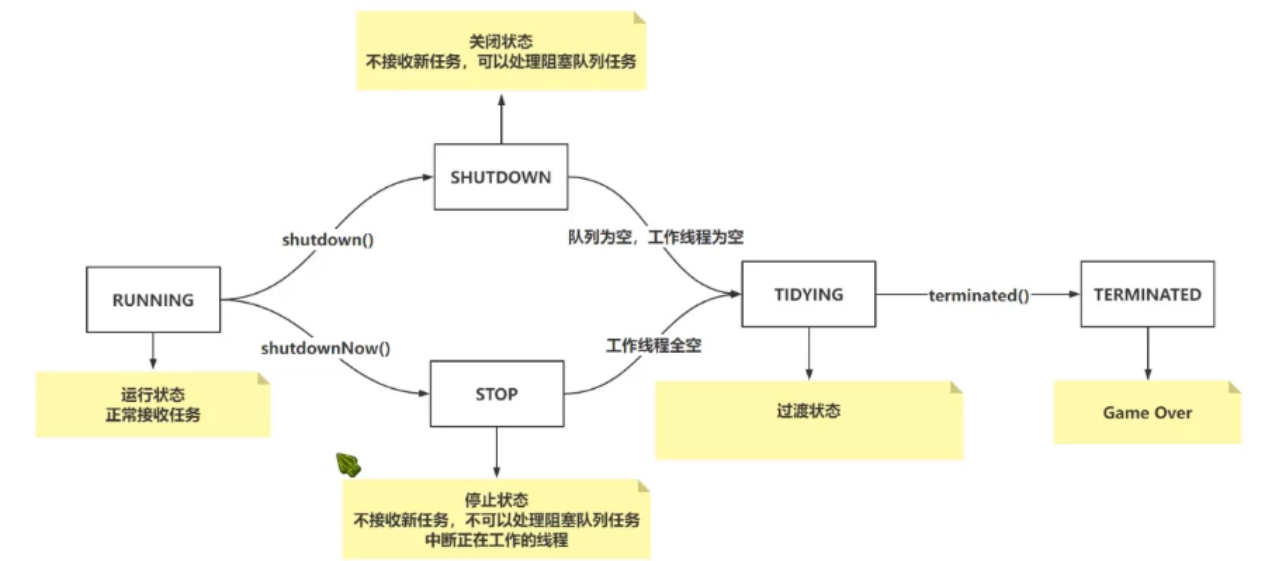Java线程池详解
线程池简介
线程池就是首先创建一些线程,它们的集合称为线程池。使用线程池可以很好地提高性能,线程池在系统启动时即创建大量空闲的线程,程序将一个任务传给线程池,线程池就会启动一条线程来执行这个任务,执行结束以后,该线程并不会死亡,而是再次返回线程池中成为空闲状态,等待执行下一个任务。
工作流程

三大常用方式
public class Demo01 { public static void main(String[] args) { // 线程池常用的三大方法 ExecutorService es = Executors.newFixedThreadPool(5);// 1池固定线程 ExecutorService es2 = Executors.newSingleThreadExecutor(); // 1池1线程 ExecutorService es3 = Executors.newCachedThreadPool(); // 1池N线程 } }
七大参数

JDK内置四种拒绝策略

AbortPolicy(默认):直接抛出 RejectedExecutionException 异常阻止系统正常运行
CallerRunsPolicy:“调用者运行”一种调节机制,该策略既不会抛弃任务,也不会抛出异常,而是将某些任务回退到调用者,从而降低新任务的流量
DiscardOldestPolicy:抛弃队列中等待最久的任务,然后把当前任务加入队列中尝试再次提交当前任务
DiscardPolicy:直接丢弃任务,不予任何处理也不抛出异常。如果允许任务丢失,这是最好的一种方案
以上内置拒绝策略均实现了RejectedExecutionHandler接口
线程池五大状态
线程池属性标识
RUNNING
正常运行状态,可以接受任务,会处理阻塞队列中的任务,可以处理当前线程中的任务
SHUTDOWN
关闭状态,不可以接受任务,但是会处理阻塞队列中的任务,且可以处理当前线程中的任务
STOP
停止状态,不可以接受任务,也不会处理阻塞队列中的任务,还会中断正在处理任务的线程
TIDYING
过渡状态,代表当前线程池即将Game Over
TERMINATED
结束状态,要执行terminated()方法,真的凉凉了
源码
/** * The main pool control state, ctl, is an atomic integer packing * two conceptual fields * workerCount, indicating the effective number of threads * runState, indicating whether running, shutting down etc * * In order to pack them into one int, we limit workerCount to * (2^29)-1 (about 500 million) threads rather than (2^31)-1 (2 * billion) otherwise representable. If this is ever an issue in * the future, the variable can be changed to be an AtomicLong, * and the shift/mask constants below adjusted. But until the need * arises, this code is a bit faster and simpler using an int. * * The workerCount is the number of workers that have been * permitted to start and not permitted to stop. The value may be * transiently different from the actual number of live threads, * for example when a ThreadFactory fails to create a thread when * asked, and when exiting threads are still performing * bookkeeping before terminating. The user-visible pool size is * reported as the current size of the workers set. * * The runState provides the main lifecycle control, taking on values: * * RUNNING: Accept new tasks and process queued tasks * SHUTDOWN: Don't accept new tasks, but process queued tasks * STOP: Don't accept new tasks, don't process queued tasks, * and interrupt in-progress tasks * TIDYING: All tasks have terminated, workerCount is zero, * the thread transitioning to state TIDYING * will run the terminated() hook method * TERMINATED: terminated() has completed * * The numerical order among these values matters, to allow * ordered comparisons. The runState monotonically increases over * time, but need not hit each state. The transitions are: * * RUNNING -> SHUTDOWN * On invocation of shutdown(), perhaps implicitly in finalize() * (RUNNING or SHUTDOWN) -> STOP * On invocation of shutdownNow() * SHUTDOWN -> TIDYING * When both queue and pool are empty * STOP -> TIDYING * When pool is empty * TIDYING -> TERMINATED * When the terminated() hook method has completed * * Threads waiting in awaitTermination() will return when the * state reaches TERMINATED. * * Detecting the transition from SHUTDOWN to TIDYING is less * straightforward than you'd like because the queue may become * empty after non-empty and vice versa during SHUTDOWN state, but * we can only terminate if, after seeing that it is empty, we see * that workerCount is 0 (which sometimes entails a recheck -- see * below). */ private final AtomicInteger ctl = new AtomicInteger(ctlOf(RUNNING, 0)); private static final int COUNT_BITS = Integer.SIZE - 3; private static final int CAPACITY = (1 << COUNT_BITS) - 1; // runState is stored in the high-order bits private static final int RUNNING = -1 << COUNT_BITS; private static final int SHUTDOWN = 0 << COUNT_BITS; private static final int STOP = 1 << COUNT_BITS; private static final int TIDYING = 2 << COUNT_BITS; private static final int TERMINATED = 3 << COUNT_BITS;
图示











【推荐】国内首个AI IDE,深度理解中文开发场景,立即下载体验Trae
【推荐】编程新体验,更懂你的AI,立即体验豆包MarsCode编程助手
【推荐】抖音旗下AI助手豆包,你的智能百科全书,全免费不限次数
【推荐】轻量又高性能的 SSH 工具 IShell:AI 加持,快人一步
· Linux系列:如何用heaptrack跟踪.NET程序的非托管内存泄露
· 开发者必知的日志记录最佳实践
· SQL Server 2025 AI相关能力初探
· Linux系列:如何用 C#调用 C方法造成内存泄露
· AI与.NET技术实操系列(二):开始使用ML.NET
· 没有Manus邀请码?试试免邀请码的MGX或者开源的OpenManus吧
· 无需6万激活码!GitHub神秘组织3小时极速复刻Manus,手把手教你使用OpenManus搭建本
· C#/.NET/.NET Core优秀项目和框架2025年2月简报
· DeepSeek在M芯片Mac上本地化部署
· 葡萄城 AI 搜索升级:DeepSeek 加持,客户体验更智能